Travelling Light: On the contents of Jong Oh’s backpack
Kristian Vistrup Madsen unpacks the few items Korean artist Jong Oh carries with him, and through them explores sculptural, spatial, and materialistic meaning in a globalised world.
“Nothing is ever yours” Jong Oh’s
mother used to say to him when he was a child. “Whatever you have in your
hands, you are only ever borrowing for a time. You arrive without anything and
you leave without anything.” Jong Oh arrives at museums and galleries with only
a small backpack. He arrives straight from the airport, yet that is all he
carries with him. “Is that all?” asks the curators and gallery assistants that
greet him, people who, after all, have quite large white rooms to fill. “Yes,
that is all.”
![]()
The backpack contains, outside of, I assume, other bare necessities – maybe a tooth brush, headphones, a passport – a store of carefully selected materials: several kinds of thread, chains ranging fine to finer, and metal rods in different lengths. He begins from a point and lets the sculpture unfold from there in response to the room as he experiences it in relation to his own body. In this way, what appears in the end is not really the frail spatial structure we barely see when we look at one of Oh’s sculptures, but the space around it. That is to say, what constitutes his work does not come out of the backpack but was there all along. His materials, then, are not so much string, chains and rods as they are place, emptiness, and the body that comes to inhabit it – first Oh’s own, as he creates it in his image, then yours and mine.
I’ve been trying to find words for this nothing which belongs to us, this anything without which we enter and leave the world, this emptiness, which Jong Oh scaffolds with the meagre contents of his bag. My first thought was dematerialisation, and Lucy Lippard’s writing on that subject.[1] In the early 1970s, Lippard described an emerging ultra-conceptual art that would no longer require studios as sites of material production. Jong Oh hasn’t had a studio in
![]()
![]()
years, much less an apartment. But rather than a strategy of formal innovation, it is a practical solution to the problem of the scarcity of affordable studios in crammed mega cities such as New York, where Oh studied, not to mention the senselessness of paying for a studio given how much he travels. I went to art school in London during the years when the rug was pulled from under the higher education system, and five or so fine art students had to share a small converted office as their so-called studio. Needless to say, art had to (de)materialise either in the Adobe suite or on the pages of a Moleskine. To boot, the global structure of the art world necessitates a lot of fairly unglamorous moving around. Here, as everywhere else, globalisation and precaritisation go hand in hand. Jong Oh, a Korean culture worker born in Mauritania, raised in Spain et al., lives and works between Brooklyn and anywhere, and shows up with his rucksack to make emptiness appear.
Lucy Lippard admits that dematerialisation is an inaccurate word: “that a piece of paper or a photograph is as much an object, or as material, as a ton of lead. Granted. But for lack of a better term I have continued to refer to a process of dematerialisation, or a de-emphasis on material aspects (uniqueness, permanence, decorative attractiveness).”[2] Jong Oh’s work certainly deemphasises the material aspects Lippard lists here. His works are not permanent, in fact, once they are deinstalled, that’s it. If someone buys the work, Oh will have to come to their house and make the piece anew according to the dimensions of the room. It won’t come out the same. The object is not valuable, he is, leading collectors to often enquire about his health. But while Oh is with Lippard as far as this de-emphasis goes, his art is not conceptual for the same reason that, though it may not be strictly about decorative attractiveness, it is decorative, because it is poetic and and sensitive; because it comes not from the mind but from the body, from a sensory apparatus so finely tuned it registers even in empty space a corporeal presence.
Jong Oh told me that, at one point, his work nearly disappeared. It was towards the end of his studies at New York’s School of Visual Arts that he made a work that was just a small black dot on a wall. It was when he realised that his material is the space itself that he allowed himself to expand back into it from the black dot. It is, therefore, not the end of a process of dematerialisation, but the opposite: a tentative and careful study of re-materialisation. A study because it seems in no way definite, but rather like a lingering question: what is the substance of the closest thing to nothing?
![]()
![]()
![]()
Here we must abandon Lippard’s vocabulary to try out a different one. It’s not the first time that I’ve attempted to mobilise the character Macabea from Clarice Lispector’s novella The Hour of the Star as an analytical model for a cultural product. I say attempted because it is not easy. Macabea is a person who scarcely has a body; nobody desires her, nobody needs her, she smiles at people in the street, but nobody smiles back “for they don’t even notice her”.[3] How can you have a story about no one? You can’t. So, much like a collector might enquire with a gallery, not into the preservation of the artwork, but as to the health of the artist, Lispector’s story is really about the one who spins it, the narrator. One Rodrigo S. M. who tries to conjure Macabea, the Northeastern girl, from her state of near-oblivion, tries to disintegrate into language in order to approximate and behold her. In the end, she comes into being only at the moment of her death – she is run over, tragically, trivially, by a yellow Mercedes. In a flash, life is constituted at its own limit, and this is her hour of stardom, the dawn of her existence, she thinks: “I am born”. But long before that happens, Rodrigo explains, “this story will emerge from a gradual vision”:
“It is the vision of the imminence of… of what? Perhaps I shall find out later. Just as I am writing at the same time as I am being read. Only I do not start with the ending that would justify the beginning – as death appears to comment on life – because I must record the preceding events.”
What we’ve been made to understand from the beginning of The Hour of the Star is that nothing ever begins. Everything is part of the same continuous unbroken process. The same process by which nothing belongs, truly, to any one person, and things happen before they actually happen. Time and space are rolled up in the same ball of yarn. Jong Oh’s sculptures begin with a dot on the wall, but they also end there. He actually put it like this: “I am writing it backwards” – a vision of the imminence of … of what? There is nothing to know until there is something to observe, and that is the end. The sculpture as we eventually see it has already happened; its appearance, like Macabea’s, is its death. We trace it forwards to the dot from which Oh wrote it backwards.
Lispector’s narrator assures us that Macabea died instantaneously: “An instant is that particle of time in which the tyre of a car going at full speed touches the ground, touches it no longer, and then touches it again.” To finish his story, he asks a question: “What is the weight of light?”.
You might understand why I was drawn to the death-as-life of Macabea in trying to find words for Oh’s nothingness. His work, I’d like to think, is the physical manifestation of the particle of time that is rubber leaving the asphalt, the weight of light. But, as I said, Macabea is an unlikely model. Lispector writes from a Brazilian context in which the poor Northeastern migrant to Rio de Janeiro is a social outlier. The narrator’s desire to grasp her liminal existence is a quasi-religious one entangled with notions of true, or pure being; scraping the bottom of the barrel for moral redemption.
The nothing that Jong Oh conjures via the contents of his rucksack is not a nothing, like Rodrigo’s that strives for oblivion but settles for its closest cousin, Macabea, but a nothing much closer to the possibility of something.
![]()
Born in Mauritania, since moving to Spain and then, at age 12, to Korea, where he lived in no less than three different cities, Jong Oh has experienced life as a succession of detachments from space, from friends, from memories. He has had to learn how to be a spider: to make a home seemingly from nothing, a home that may easily be destroyed, but was never meant to last anyway.
Like many people, I can relate to this. Like the millions of exchange students and expatriate workers for multinational companies the world over that pace one-bedroom flats with their headsets. From the building across the street, you’d see them gesticulating at empty space, but we know that they’re Skyping across six hours’ time-difference. Ours is not the experience of marginalisation and disenfranchisement that structures Macabea’s invisibility. No, it’s rather a mundane experience of confusion, loneliness and isolation that are the symptoms of troubled acculturation.
I was introduced to the concept of acculturation in a report called Human Mobility in a Global Era.[4] It also says that though “much of the world has shrunk, the adaptation problems of people who move remain the same … Tough military people, highly committed teachers, and aid workers break down, and have to be repatriated.” I remember sitting in my cell of a dorm room in London clinging to what my analyst has since named my transitory objects: a candle holder, a tea pot, and an ash tray of Murano glass. I learned from the report that “Personal characteristics associated with successful expatriation include technical ability, stress tolerance, flexibility, communication skills and cultural empathy.” I’ve never been very good at moving, hence my desperate dependence on material artefacts.
![]()
![]()
Jong Oh, as we know from what his mother taught him of the existentially transitory nature of ownership, has a rather different relationship to objects. “I don’t stress about the travelling”, he told me, “I have to be very open, flexible and intuitive” – thus, he travels light. He does not require specific things to ground his presence. Rather, as an artist, he has made it his special gift to conceive of any given space as a grounding substance. The work is the result of an intimate conversation between Oh and the room, of reaching an understanding of the durability of different materials, producing just the right amount of tension for a shape to maintain itself. To make these shapes appear, and with them, the space itself, is a way of acculturating to it, of inhabiting it, and making a home there.
This is an ambivalent manoeuvre, because the work (the space) will inevitably also deliver something of you, Jong Oh, into view, at the same time as it isolates you, Jong Oh, from the potential others. The conversation between artist and room is a quiet one that only they can hear. “I never know how the audience feels”, Oh said to me, “because they experience it the other way around.” As such, his work stages the alienation inherent not only our relationships to others, but also to ourselves. To begin to comprehend this gap, however, is crucially also the first step in bridging it.
Returning to Lucy Lippard, she once said about Eva Hesse, that “even if you didn’t know Eva, you’d know more about her than you realised from looking at her work. Because you’ve been connected somehow. That’s one of the beautiful things about her work, that it does really reach out and make connection.”[5] So much about being and corporeality, there’s more at stake in the at-first-glance minimalism of Hesse than dematerialisation, making her quite a useful reference point for thinking about Jong Oh’s work as well. What Barry Schwabsky wrote about Hesse, could easily be said of Oh, too: “you can look at these things, these materials, these shapes, and feel the shudder of an un-nameable nano-sensation, or you can let your eye pass by them without reaction.”[6] When Oh wonders how the audience feels upon encountering his work, as a member of said audience I’d respond, after Schwabsky: the shudder of an un-nameable nano-sensation. Captured in the webs of Oh’s temporary homes are the outlines of objects that may or may not have been there before, the friendly ghosts of memories, echoes of intention.
Contrary to Lispector’s example, this exercise is not about shedding subjectivity, but accepting the conditions for subjectivity as highly unstable. Oh has compared his method to navigating open seas, even naming exhibitions after navigation tools. This is a practice of hurling an anchor at the stars, finding points in the sky by which to fasten yourself, and draw from them familiar forms that can be yours to own and to know, if only for a short while. Of course, threads and chains and metal levers are soon disassembled, the backpack zipped shut. Sure, we come with nothing and leave with nothing, but that’s not to say that there’s nothing in between.
![]()
[1] See Lucy R. Lippard, Six
Years: The Dematerialization of the Art Object from 1966 to 1972, University of California Press, 1973.

The backpack contains, outside of, I assume, other bare necessities – maybe a tooth brush, headphones, a passport – a store of carefully selected materials: several kinds of thread, chains ranging fine to finer, and metal rods in different lengths. He begins from a point and lets the sculpture unfold from there in response to the room as he experiences it in relation to his own body. In this way, what appears in the end is not really the frail spatial structure we barely see when we look at one of Oh’s sculptures, but the space around it. That is to say, what constitutes his work does not come out of the backpack but was there all along. His materials, then, are not so much string, chains and rods as they are place, emptiness, and the body that comes to inhabit it – first Oh’s own, as he creates it in his image, then yours and mine.
I’ve been trying to find words for this nothing which belongs to us, this anything without which we enter and leave the world, this emptiness, which Jong Oh scaffolds with the meagre contents of his bag. My first thought was dematerialisation, and Lucy Lippard’s writing on that subject.[1] In the early 1970s, Lippard described an emerging ultra-conceptual art that would no longer require studios as sites of material production. Jong Oh hasn’t had a studio in
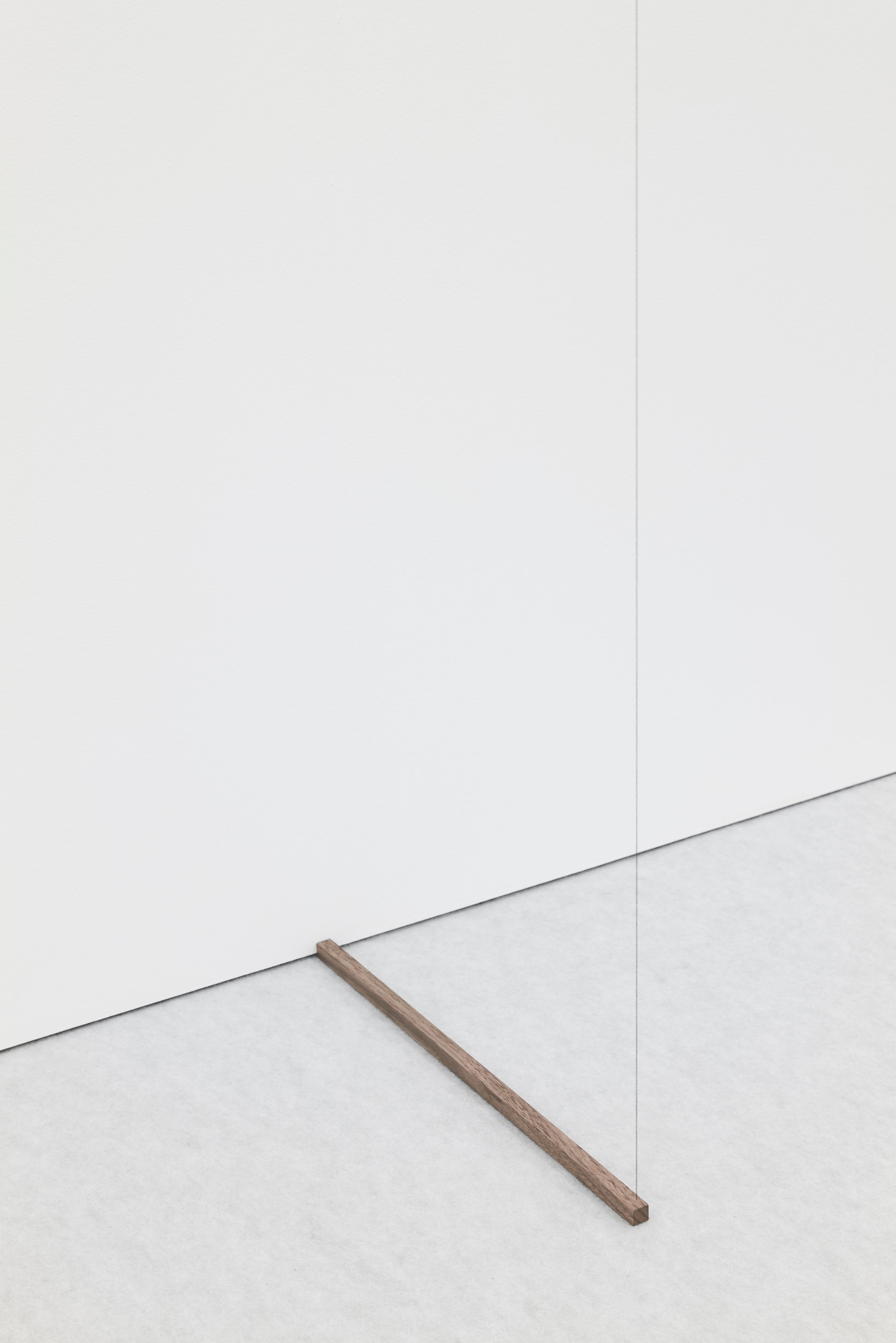
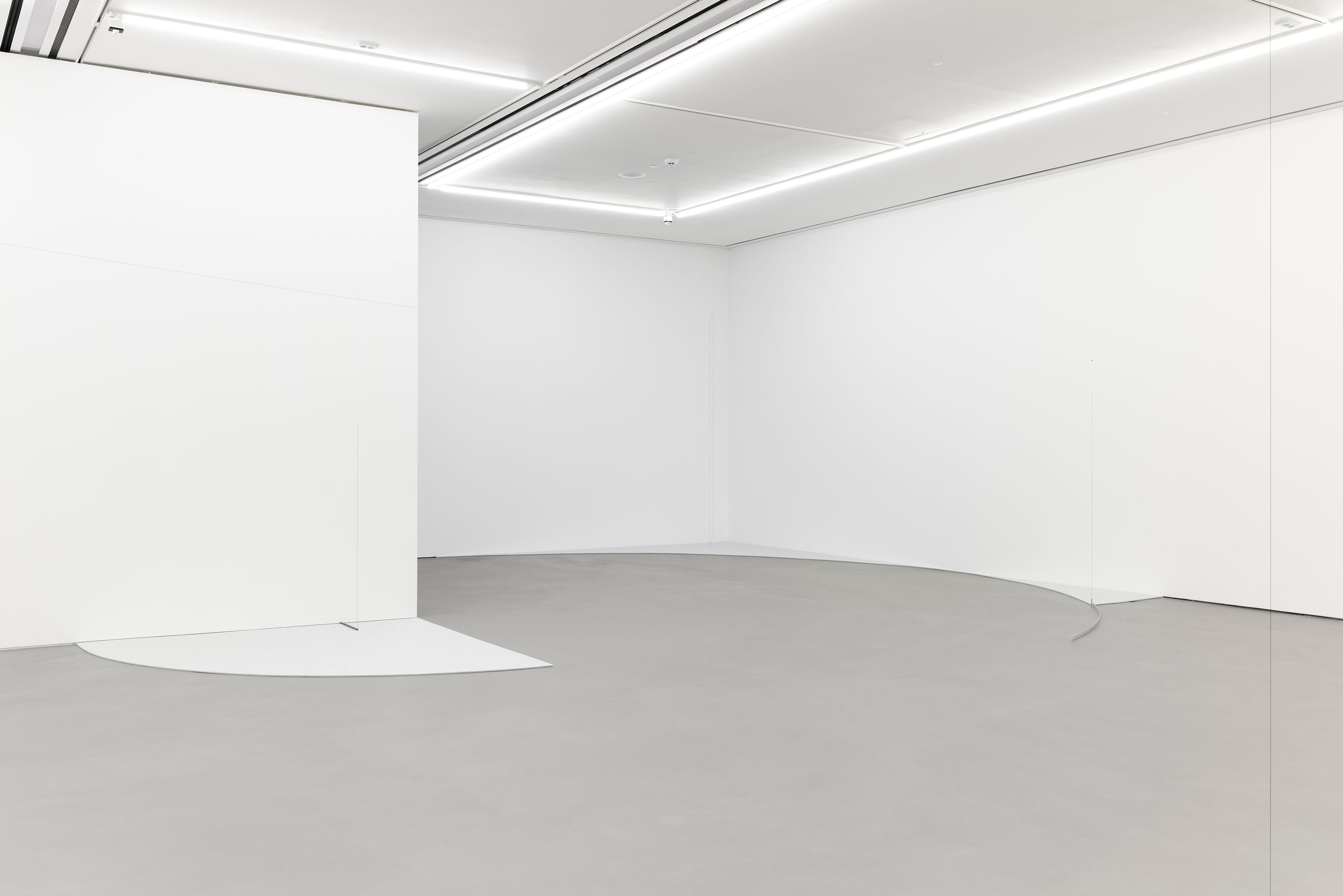
years, much less an apartment. But rather than a strategy of formal innovation, it is a practical solution to the problem of the scarcity of affordable studios in crammed mega cities such as New York, where Oh studied, not to mention the senselessness of paying for a studio given how much he travels. I went to art school in London during the years when the rug was pulled from under the higher education system, and five or so fine art students had to share a small converted office as their so-called studio. Needless to say, art had to (de)materialise either in the Adobe suite or on the pages of a Moleskine. To boot, the global structure of the art world necessitates a lot of fairly unglamorous moving around. Here, as everywhere else, globalisation and precaritisation go hand in hand. Jong Oh, a Korean culture worker born in Mauritania, raised in Spain et al., lives and works between Brooklyn and anywhere, and shows up with his rucksack to make emptiness appear.
Lucy Lippard admits that dematerialisation is an inaccurate word: “that a piece of paper or a photograph is as much an object, or as material, as a ton of lead. Granted. But for lack of a better term I have continued to refer to a process of dematerialisation, or a de-emphasis on material aspects (uniqueness, permanence, decorative attractiveness).”[2] Jong Oh’s work certainly deemphasises the material aspects Lippard lists here. His works are not permanent, in fact, once they are deinstalled, that’s it. If someone buys the work, Oh will have to come to their house and make the piece anew according to the dimensions of the room. It won’t come out the same. The object is not valuable, he is, leading collectors to often enquire about his health. But while Oh is with Lippard as far as this de-emphasis goes, his art is not conceptual for the same reason that, though it may not be strictly about decorative attractiveness, it is decorative, because it is poetic and and sensitive; because it comes not from the mind but from the body, from a sensory apparatus so finely tuned it registers even in empty space a corporeal presence.
Jong Oh told me that, at one point, his work nearly disappeared. It was towards the end of his studies at New York’s School of Visual Arts that he made a work that was just a small black dot on a wall. It was when he realised that his material is the space itself that he allowed himself to expand back into it from the black dot. It is, therefore, not the end of a process of dematerialisation, but the opposite: a tentative and careful study of re-materialisation. A study because it seems in no way definite, but rather like a lingering question: what is the substance of the closest thing to nothing?
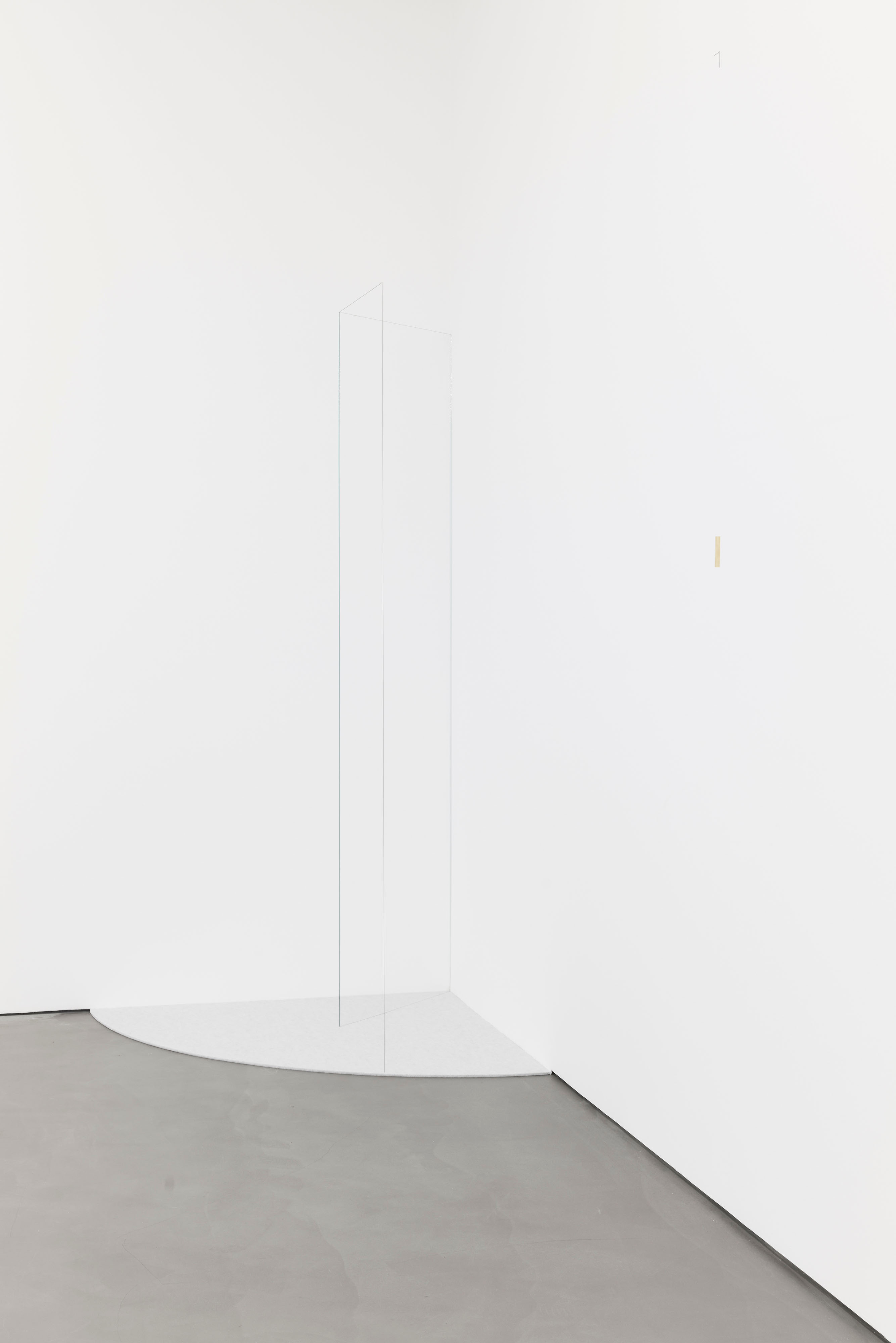

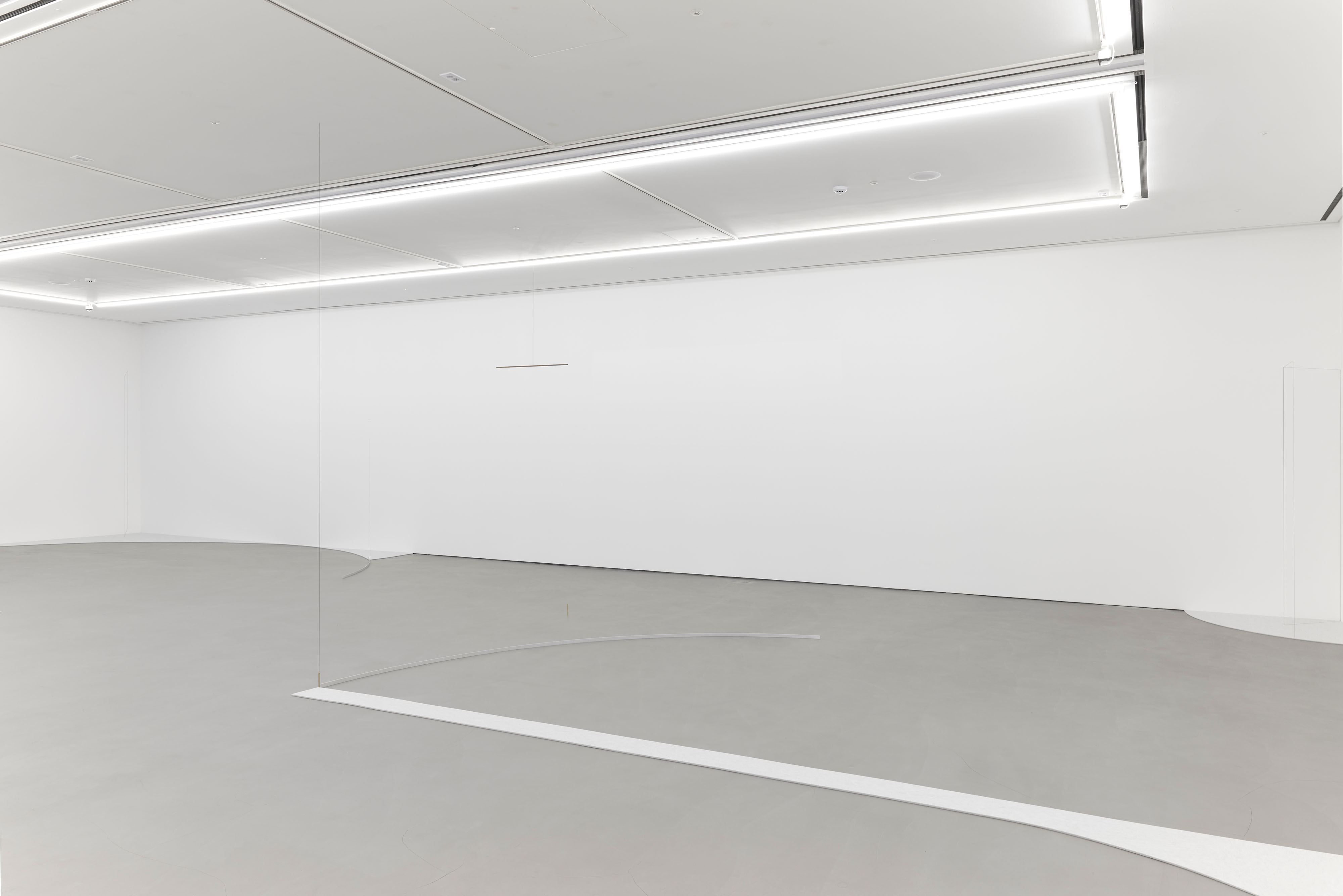
Here we must abandon Lippard’s vocabulary to try out a different one. It’s not the first time that I’ve attempted to mobilise the character Macabea from Clarice Lispector’s novella The Hour of the Star as an analytical model for a cultural product. I say attempted because it is not easy. Macabea is a person who scarcely has a body; nobody desires her, nobody needs her, she smiles at people in the street, but nobody smiles back “for they don’t even notice her”.[3] How can you have a story about no one? You can’t. So, much like a collector might enquire with a gallery, not into the preservation of the artwork, but as to the health of the artist, Lispector’s story is really about the one who spins it, the narrator. One Rodrigo S. M. who tries to conjure Macabea, the Northeastern girl, from her state of near-oblivion, tries to disintegrate into language in order to approximate and behold her. In the end, she comes into being only at the moment of her death – she is run over, tragically, trivially, by a yellow Mercedes. In a flash, life is constituted at its own limit, and this is her hour of stardom, the dawn of her existence, she thinks: “I am born”. But long before that happens, Rodrigo explains, “this story will emerge from a gradual vision”:
“It is the vision of the imminence of… of what? Perhaps I shall find out later. Just as I am writing at the same time as I am being read. Only I do not start with the ending that would justify the beginning – as death appears to comment on life – because I must record the preceding events.”
What we’ve been made to understand from the beginning of The Hour of the Star is that nothing ever begins. Everything is part of the same continuous unbroken process. The same process by which nothing belongs, truly, to any one person, and things happen before they actually happen. Time and space are rolled up in the same ball of yarn. Jong Oh’s sculptures begin with a dot on the wall, but they also end there. He actually put it like this: “I am writing it backwards” – a vision of the imminence of … of what? There is nothing to know until there is something to observe, and that is the end. The sculpture as we eventually see it has already happened; its appearance, like Macabea’s, is its death. We trace it forwards to the dot from which Oh wrote it backwards.
Lispector’s narrator assures us that Macabea died instantaneously: “An instant is that particle of time in which the tyre of a car going at full speed touches the ground, touches it no longer, and then touches it again.” To finish his story, he asks a question: “What is the weight of light?”.
You might understand why I was drawn to the death-as-life of Macabea in trying to find words for Oh’s nothingness. His work, I’d like to think, is the physical manifestation of the particle of time that is rubber leaving the asphalt, the weight of light. But, as I said, Macabea is an unlikely model. Lispector writes from a Brazilian context in which the poor Northeastern migrant to Rio de Janeiro is a social outlier. The narrator’s desire to grasp her liminal existence is a quasi-religious one entangled with notions of true, or pure being; scraping the bottom of the barrel for moral redemption.
The nothing that Jong Oh conjures via the contents of his rucksack is not a nothing, like Rodrigo’s that strives for oblivion but settles for its closest cousin, Macabea, but a nothing much closer to the possibility of something.
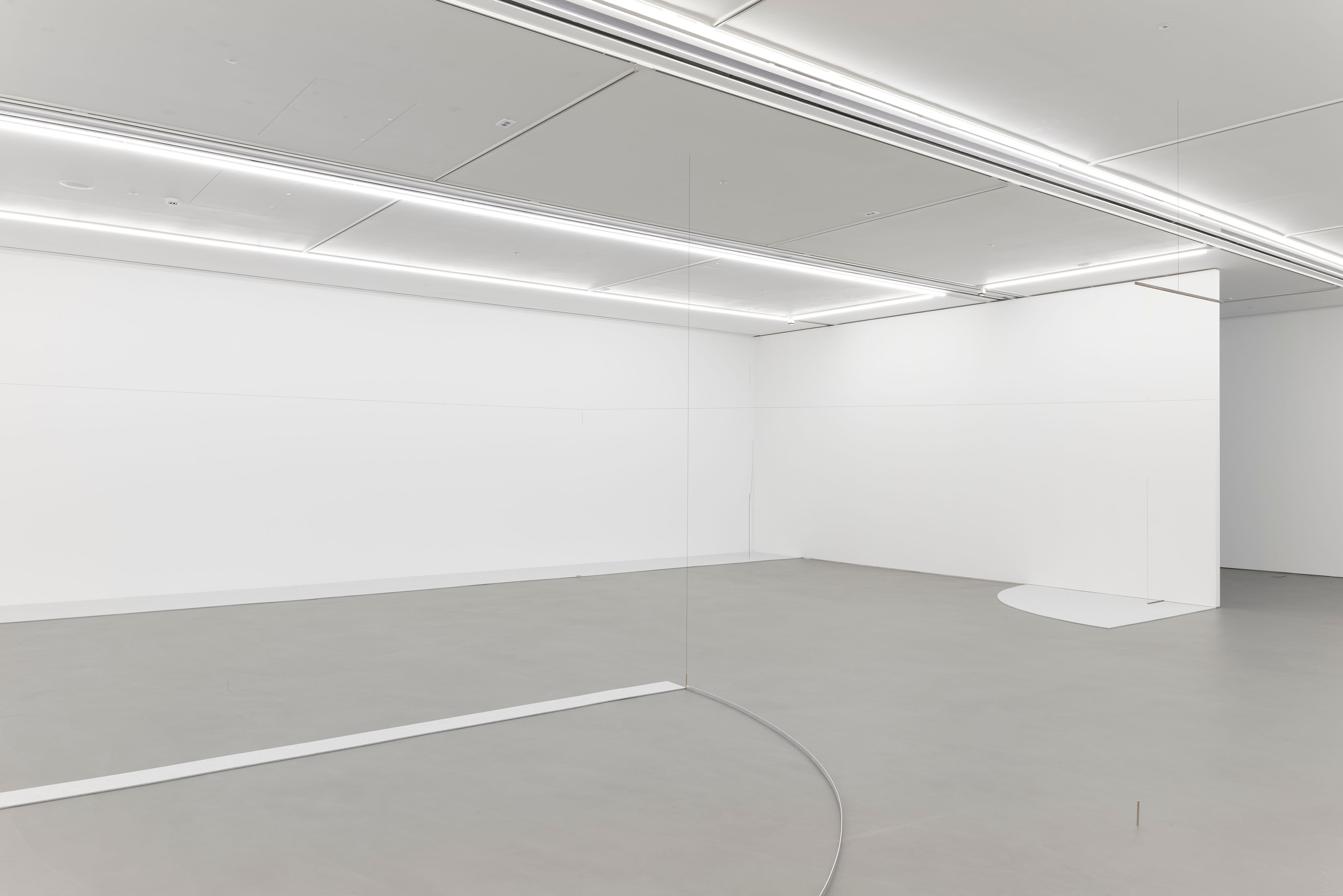
Born in Mauritania, since moving to Spain and then, at age 12, to Korea, where he lived in no less than three different cities, Jong Oh has experienced life as a succession of detachments from space, from friends, from memories. He has had to learn how to be a spider: to make a home seemingly from nothing, a home that may easily be destroyed, but was never meant to last anyway.
Like many people, I can relate to this. Like the millions of exchange students and expatriate workers for multinational companies the world over that pace one-bedroom flats with their headsets. From the building across the street, you’d see them gesticulating at empty space, but we know that they’re Skyping across six hours’ time-difference. Ours is not the experience of marginalisation and disenfranchisement that structures Macabea’s invisibility. No, it’s rather a mundane experience of confusion, loneliness and isolation that are the symptoms of troubled acculturation.
I was introduced to the concept of acculturation in a report called Human Mobility in a Global Era.[4] It also says that though “much of the world has shrunk, the adaptation problems of people who move remain the same … Tough military people, highly committed teachers, and aid workers break down, and have to be repatriated.” I remember sitting in my cell of a dorm room in London clinging to what my analyst has since named my transitory objects: a candle holder, a tea pot, and an ash tray of Murano glass. I learned from the report that “Personal characteristics associated with successful expatriation include technical ability, stress tolerance, flexibility, communication skills and cultural empathy.” I’ve never been very good at moving, hence my desperate dependence on material artefacts.


Jong Oh, as we know from what his mother taught him of the existentially transitory nature of ownership, has a rather different relationship to objects. “I don’t stress about the travelling”, he told me, “I have to be very open, flexible and intuitive” – thus, he travels light. He does not require specific things to ground his presence. Rather, as an artist, he has made it his special gift to conceive of any given space as a grounding substance. The work is the result of an intimate conversation between Oh and the room, of reaching an understanding of the durability of different materials, producing just the right amount of tension for a shape to maintain itself. To make these shapes appear, and with them, the space itself, is a way of acculturating to it, of inhabiting it, and making a home there.
This is an ambivalent manoeuvre, because the work (the space) will inevitably also deliver something of you, Jong Oh, into view, at the same time as it isolates you, Jong Oh, from the potential others. The conversation between artist and room is a quiet one that only they can hear. “I never know how the audience feels”, Oh said to me, “because they experience it the other way around.” As such, his work stages the alienation inherent not only our relationships to others, but also to ourselves. To begin to comprehend this gap, however, is crucially also the first step in bridging it.
Returning to Lucy Lippard, she once said about Eva Hesse, that “even if you didn’t know Eva, you’d know more about her than you realised from looking at her work. Because you’ve been connected somehow. That’s one of the beautiful things about her work, that it does really reach out and make connection.”[5] So much about being and corporeality, there’s more at stake in the at-first-glance minimalism of Hesse than dematerialisation, making her quite a useful reference point for thinking about Jong Oh’s work as well. What Barry Schwabsky wrote about Hesse, could easily be said of Oh, too: “you can look at these things, these materials, these shapes, and feel the shudder of an un-nameable nano-sensation, or you can let your eye pass by them without reaction.”[6] When Oh wonders how the audience feels upon encountering his work, as a member of said audience I’d respond, after Schwabsky: the shudder of an un-nameable nano-sensation. Captured in the webs of Oh’s temporary homes are the outlines of objects that may or may not have been there before, the friendly ghosts of memories, echoes of intention.
Contrary to Lispector’s example, this exercise is not about shedding subjectivity, but accepting the conditions for subjectivity as highly unstable. Oh has compared his method to navigating open seas, even naming exhibitions after navigation tools. This is a practice of hurling an anchor at the stars, finding points in the sky by which to fasten yourself, and draw from them familiar forms that can be yours to own and to know, if only for a short while. Of course, threads and chains and metal levers are soon disassembled, the backpack zipped shut. Sure, we come with nothing and leave with nothing, but that’s not to say that there’s nothing in between.
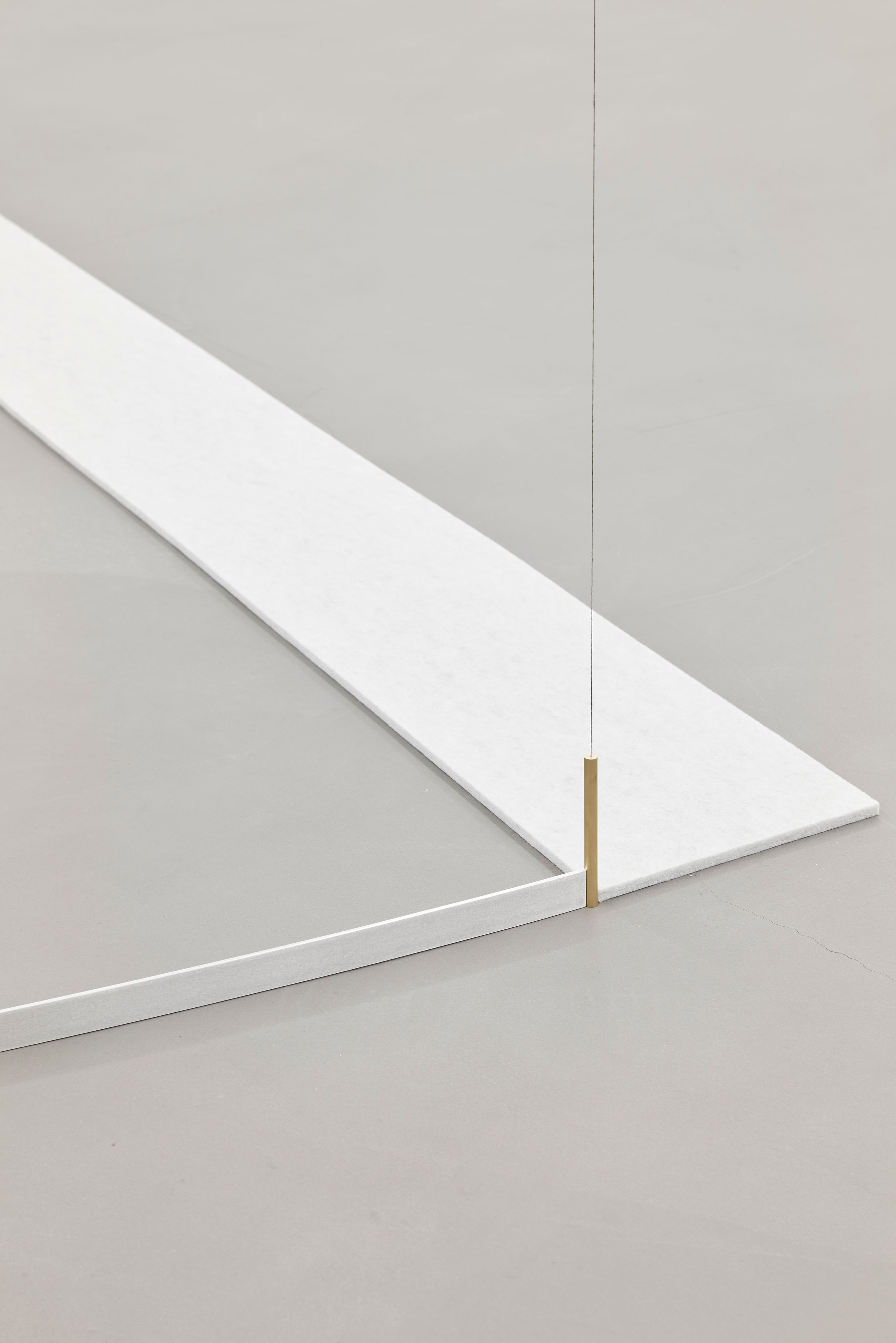
[1] See Lucy R. Lippard, Six
Years: The Dematerialization of the Art Object from 1966 to 1972, University of California Press, 1973.
[2] Quoted in Owen Duffy, “What
Was Dematerialization? (And What Does It Mean in the Age of "The Cloud”?)” at Art Space, Jan 7, 2010. Available at: www.artspace.com/magazine/art_101/close_look/what-was-dematerialization-54528
[3] Lispector. Clarice, The Hour of the
Star, translation Giovanni Pontiero, London: Carcanet, 1986 (orig. 1977).
[4] Furnan, Adrian, “Human mobility in a global era” in The Psychology of Global Mobility, 2010.
[5] Lippard, Lucy R. et al., “Out of the
past: a conversation on Eva Hesse” in Artforum, February 2008.
[6] Schwabsky. Barry, “Eva Hesse at Camden
Arts Centre” in Artforum, April 2010.
Kristian Vistrup Madsen writes art criticism for Artforum, Frieze, Mousse and others. He is the author of Doing Time: Essays on Using People (2021), and the winner of the 2020 Broken Dimanche Press novel prize. He lives in Berlin.
www.kristianvistrup.dk/
Jong Oh (b. 1981, Mauritania) is a South Korean artist living and working between Seoul and New York. His artistic practice does not use a studio but creates minimal sculptures in situ that respond to a given spatial situation. Responding to the nuanced configuration of each site, the artist constructs spatial structures by suspending and interconnecting a limited selection of materials: rope, chains, fishing wire, perspex, wooden and metal rods and painted threads.
images
This essay was written for the catalogue of Jong Oh’s exhibition at Galerie Jochen Hempel, Leipzig, later this year.
images
all images courtesy of Doosan Gallery, Photos
© Heeseung Chung
publication date
31 January 2022
tags
Absence, Backpack, Dematerialisation, Galerie Jochen Hempel, Lucy Lippard,
Clarice
Lispector,
Macabea, Materiality, Nothing, Jong Oh, Sculpture, Kristian Vistrup Madsen
publication date
31 January 2022
tags
Absence, Backpack, Dematerialisation, Galerie Jochen Hempel, Lucy Lippard, Clarice Lispector, Macabea, Materiality, Nothing, Jong Oh, Sculpture, Kristian Vistrup Madsen


